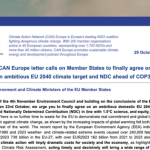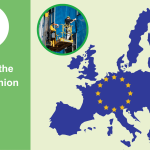Only through unified, bold action, already in this decade, can Europe avoid the catastrophic consequences of climate change. For the EU to meet its 2030 climate objective (55% net emissions reductions compared to 1990 levels) and, even more so, to do its fair share under the Paris Agreement (for which 76% net emissions reductions are needed), all Member States must accelerate their national climate, energy and just transition efforts through their NECPs.
What are NECPs?
National Energy and Climate Plans, or NECPs, outline European countries’ climate and energy targets and the policies and measures they will implement to achieve them by 2030 (with a longer-term outlook to 2040 and beyond). NECPs are binding documents under the EU Governance Regulation, but also, if implemented in a timely and ambitious manner, a powerful tool to achieve climate neutrality and ensure a just transition – both at the centre of the EU Green Deal and also pursued in the new EU Strategic Agenda (2024-29).
EU Member States were required to submit their final updated National Energy and Climate Plans (NECPs) to the European Commission by 30 June 2024. As of 16 October 2024, only 13 of the 27 final NECP updates had been submitted.
About the NECP tracker
The NECP Tracker, developed by Climate Action (CAN) Europe together with the other 13 partners of the TogetherFor1.5 project, is a tool that monitors and assesses the implementation of national climate and energy policies. It has a double function: on the one hand, it assesses the ambition of the latest available NECPs (i.e. either the draft or final updates) by comparing them with EU 2030 climate targets and energy benchmarks. On the other hand, it monitors whether national governments are implementing their old 2019 NECPs as planned, by comparing them with historical data.
The NECP tracker currently covers 17 EU Member States: Belgium, Bulgaria, Croatia, Cyprus, Czechia, Denmark, Estonia, France, Germany, Greece, Hungary, Ireland, Italy, Poland, Portugal, Slovenia and Spain.
Through a transparent collection of data on key indicators, the tracker aims to show the importance of nationally binding climate and energy targets to monitor their implementation and levels of ambition. The selected indicators give an overview of where Member States really stand, what they have promised and how far they are from the minimum EU requirements. By doing so, it provides key information to identify policy gaps in the ambition and implementation of national climate action.
General findings
Below is a summary of key findings related to the 2024 edition of the NECP tracker (a more detailed assessment is available in the briefing). Significant differences exist between Member States covered by the tool, in terms of trends and contexts, but also in terms of quality and availability of national data. Also, at the time national data was extracted, several Member States had not yet submitted their final NECP updates, and several versions of the draft NECP updates were circulating. Nonetheless, it is possible to draw some general conclusions.
– Ambition towards 2030 targets –
Despite some improvements, the current level of ambition of the latest available NECP updates (i.e. final or, when lacking, the latest draft versions) is insufficient not only to align with Paris Agreement commitments but also to reach the EU 2030 climate and energy objectives.
- The aggregate level of ambition of the draft NECP updates, submitted by Member States to the European Commission in 2023, was insufficient for the EU to achieve its 2030 climate and energy targets (let alone align with the Paris Agreement) while delivering a just transition. This was already highlighted by several NGO reports (for instance here and here), by the ESABCC and by the European Commission, both in its assessment of the draft NECPs (December 2023) and, more recently, by the 2024 State of the Energy Union report. The new update of the NECP tracker confirms these findings.
- The final NECP updates submitted so far show some improvement in ambition levels compared to the drafts, but not as much as required. All 6 countries featured in the tracker have increased their targets for Effort-Sharing sectors to align with EU legislation; some have also increased their LULUCF, energy efficiency and renewable energy targets. However, in many cases, these are just paper targets, as they lack the necessary policy support to ensure effective implementation (which can be verified with WAM scenarios). Some countries have even taken a step backward compared to the drafts. None of the plans pledge energy efficiency national contributions that equal the most ambitious results of the EED formula.
- The delay in submitting the final NECP updates – only 13 out of 27 as of 16 October 2024, three months after the deadline – is in itself an alarming signal that Member States are neglecting their responsibility and their legal duty to plan and deliver 2030 climate and energy targets.
- Some countries that still have to submit the final NECP updates have circulated updated versions of the drafts (for instance in Bulgaria, Czechia, Greece, Poland, Portugal and Slovenia). Improvements compared to previous versions are mixed but overall insufficient.
– Implementation of NECPs as of 2022 –
The implementation of the old 2019 NECPs is lagging behind. All Member States assessed in the tracker seem to show some worrying trends and gaps in keeping up with their old pledges.
The NECP tracker provides a bird’s eye perspective on whether Member States were, as of 2022, on track to achieve the climate and energy objectives of their old 2019 NECPs. Its latest update reveals that:
- While positive examples exist, as of 2022, EU Member States were not fully on track with their 2019 NECP trajectories and objectives. All of the 17 EU Member States featured in the tracker were lagging behind in at least one of the NECP tracker indicators.
- Several countries are not in line with at least one of their overall greenhouse gas emission reduction targets (net or gross). In many cases, the delay has been caused by too slow a decarbonisation rate in the sectors covered by the Effort-Sharing Regulation. As of 2022, 8 out of the 17 countries featured in the tracker were not aligning with the non-ETS targets or trajectories of the old 2019 NECPs. This is especially worrying given that ESR targets have been revised and raised as part of Fit for 55.
- Among non-ETS sectors, transport is the one that raises most concerns. As of 2022, implementation of the old 2019 NECP trajectories was not on track in 10 out of 17 countries. The NECP tracker’s findings confirm the assessment of the 2024 State of the Energy Union report, which indicates transport as one of the sectors where ‘required emissions reductions are significant’ to meet the 2030 targets. Other sectors lagging behind are agriculture, waste and LULUCF.
- For energy indicators, the tracker shows mixed results. Despite wind and solar taking up all over the EU, the untapped potential for renewables remains high, as the share of renewables in electricity generation and/or final energy consumption was off track with expected trajectories in 10 out of the 17 countries.
- Energy consumption indicators show a slightly more positive picture. However, the 2020-2022 period was unusual due to the COVID pandemic and high energy prices which, according to the EEA, had a significant impact on energy consumption. An accelerated implementation of energy savings measures is needed to meet the 2030 EU energy efficiency target
– Quality of data in the NECP updates –
NECPs present varying but overall poor transparency and quality of data, which hinders the plans’ credibility as well as access to information.
While updating the NECP tracker, the authors found several gaps and inconsistencies in the data in both draft and final updated NECPs, as well as in the old 2019 NECPs. Below, we provide an overview of the most common critical aspects found during our analysis of the plans.
- Unavailability and complex accessibility of data – In many circumstances, either targets or (more often) WEM and WAM scenarios, were not adequately provided. In some cases, targets or scenarios were simply missing. In other cases, it was extremely difficult to access data: values were either provided only in percentages (and not in absolute terms); or they were provided only within graphs with little to no explanation or context. The unavailability of data severely undermines transparency and access to information and prevents an effective analysis of the plans.
- Lack of consistency with EU datasets – In some circumstances, historical data in the NECPs – which constitute the baseline to derive 2030 targets and scenarios – do not match historical data of the EEA and Eurostat datasets. This lack of consistency affects the quality and reliability of the plans and, consequently, the ability of third parties to assess them.
As highlighted in the previous NECP tracker update, as well as in a report assessing the main gaps in transparency and access to climate data, easily-accessible, good-quality, and consistent data are key for planning effective policies and identifying gaps. These are also essential for just transition, improved stakeholder and civil society involvement in planning and decision-making processes, in line with the Aarhus Convention.



